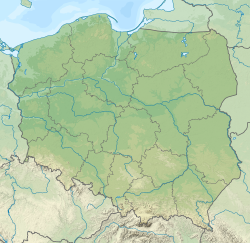Zagaje Formation
| Zagaje Formation | |
|---|---|
| Stratigraphic range: Latest Rhaetian-Lower Sinemurian~[1] | |
 Exposed Layers at Sołtyków | |
| Type | Geological formation |
| Unit of | Kamienna Group |
| Sub-units | Huta Mudstone Member |
| Underlies | |
| Overlies | Unnamed Rhaetian Beds |
| Area | Polish epicontinental basin except of the Mazury region and Czêstochowa region. Reaches also into north Germany |
| Thickness | 157.5 m |
| Lithology | |
| Primary | Sandstone |
| Other | Mudstone |
| Location | |
| Coordinates | 51°06′N 20°30′E / 51.1°N 20.5°E |
| Approximate paleocoordinates | 43°06′N 18°48′E / 43.1°N 18.8°E |
| Region | Swietokrzyskie |
| Country | |
| Type section | |
| Named for | The Town of Zagaje near Gromadzice |
| Named by | Karaszewski (as an informal unit)[3] |
The Zagaje Formation is a Latest Triassic-Early Jurassic Epoch (Rhaetian-Sinemurian) geologic formation located mostly in Poland with layers also exposed in north Germany. This unit is known for its diverse Ichnofossil assemblages, with traces of invertebrates along vertebrate footprints, as well plants, large coal accumulations, invertebrate remains and ichnofossils.[4] The Zagaje Formation correlates with The lower part of the Höganäs Formation in Scania, as well the Munkerup Member and the Gassum Formation in Denmark.[1]
Paleoenvironment
[edit]The Zagaje Formation is particularly visible in the Sołtyków region and is made mostly of Early Jurassic continental mudstone-sandstone deposits linked to the onset of "depositional sequence I". Its age is confirmed as mostly Early Hettangian through stratigraphic and paleontological analyses, including fossil flora and conchostraca findings. Sedimentological studies divide the Sołtyków profile into three parts: ephemeral reservoir deposits, floodplain and lacustrine sediments, and river channel deposits, highlighting dynamic depositional environments influenced by tectonic subsidence and varying hydrological conditions.[1][5][6]
Climate wise, the area was located back in the Hettangian around 45°N paleolatitude in Laurasia within a rise of 5–10°C above present, were it experienced significant climatic and environmental change related with sea-level fluctuations, manifested locally with a notorious retrogradational fluvial-lacustrine sedimentation, with evidence of a humid climate interspersed with drier seasons. Some plant fossils like Hirmeriella mark points of aridity on what was mostly a humid swampy alluvial-lacustrine habitat.[7][8]
The Zagaje Formation’s deposits are know from both outcrops and borehole profiles that consist primarily of sandstones, mudstones, and interspersed coal and siderite layers. It represents a stratigraphic gap with the underlying Upper Triassic formations and is capped by a transgressive contact with the Skłoby Formation.[1] This unit contains freshwater fauna and diverse trace fossils, including vertebrate tracks.[5][9] The paleoenvironment reflects a dynamic alluvial plain shaped predominantly by high-sinuosity stream processes, transitioning from earlier braided and low-sinuosity stream systems. This evolution is attributed to climatic changes, rising base levels, and decreasing geomorphological gradients. Observations, both from exposures and borehole data, highlight the dominance of avulsion processes, with several depositional subsystems identified. Facies with organic remains are diverse: riverbed biofacies, derived from meandering channels characterized by fining-upward sequences composed of channel lag deposits, point-bar sands, and finer overlying sediments.[6] These deposits exhibit lateral accretion bedding and significant fossil bivalves and large-sized floated plant remains (stems and trunks of large plants) consistent with subaqueous dune migration within the channels; levee deposits derived from successive floods with scarce root traces, while plant remnants are common; Paleosoils with sparse traces of plant roots and remains of floating plants of highly variable size (mainly organic detritus, but also fragments of wood), fragments of bivalve shells and vertebrate remains (amniote bones, tracks, fish scales); the biofacies of the ephemeral water reservoir with plant remains, mainly horsetails, and fossils of insects, ostracods, and conchostraca; The pedogenic soil biofacies with remains of plant roots with preserved organic matter and rhizomes and stems in a living position; Floodplain biofacies with traces of numerous plant roots and plant macroremains, and remains of sedge stems preserved in a living position; Lake-marsh biofacies, dark, laminated mudstones with plant roots and coal, with few fossil bivalves, a large amount of organic matter in the form of plant detritus, and layers of coal and numerous finds of miospores and megaspores.[5][6][8] The local presence of charcoal fragments and high concentrations of PAHs, along with possible burnt plants, provides evidence for wildfires in the region, that likely occurred near the surface with charred wood fragments were subsequently incorporated into sediments by river transport.[10]
The high presence of coprolites has allow also to stablish the tropic chain of the local biota, with a clear full ecosystemical substitution of the older Triassic archosaurs by Dinosaurs.[11][12]
Biota
[edit]Indet. Invertebrates
[edit]Several unname Ichnofossils are recovered at Soltyków, including conical domichnia (Conichnus?), bivalve straight to winding linear trails, smooth vertical and subvertical branching tunnels, knob-walled tunnels, mace-shaped or irregular ellipsoid chambers, etc.[13][14]
| Genus | Species | Location | Material | Made By |
|---|---|---|---|---|
|
|
Dwelling structures |
| |
|
|
Traces |
| |
|
|
Subcylindrical burrows |
| |
|
|
Hypichnial trackway |
| |
|
|
U-Shaped Burrows |
| |
|
|
Burrows |
| |
|
|
V-shaped hypichnial marks |
| |
|
|
Straight or slightly curved burrows |
| |
|
|
Horizontal burrows |
| |
|
|
Resting Traces |
| |
|
|
Moving Traces |
| |
|
|
Linear slender burrows |
| |
|
|
Sac/Bottle shaped burrows |
| |
|
|
Sac/Bottle shaped burrows |
|
Molluscs
[edit]Indeterminate gastropod egg capsules are know, similar to the ones recovered in the extant Neritina.[15] 4 unnamed morphotypes of freshwater bivalves of the family Unionidae are know.[5]
| Genus | Species | Location | Material | Notes | Images |
|---|---|---|---|---|---|
| Anodonta[16][17] |
|
|
Isolated Shells | A freshwater mussel, member of the family Unionidae |  |
| Calceoformites[13][14] |
|
|
Clog-shaped protrusions | Bivalve estabilization traces | |
| Cardinia[15] |
|
|
Isolated Shells | A Carditidae Bivalve. Indicator of oligohaline settings and found also on the younger Skłoby Formation | |
| Lockeia[1][13] |
|
|
Dwelling traces | Resting traces of Bivalves | 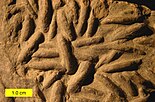 |
| Ptychoplasma[18] |
|
|
Locomotion trace | Gastropod Locomotion traces | |
| Scalichnus[1][13][14] |
|
|
Sac/Bottle shaped burrows | Escape structure of mud-dwelling bivalves | |
| Scolicia[1][13] |
|
|
Traces | Locomotion and feeding trace of gastropods | |
| Unio[16][19] |
|
|
Isolated Shells | A freshwater mussel, member of the family Unionidae |  |
| Viviparus[16][20] |
|
|
Isolated Shells | A freshwater snail, member of the family Viviparidae | 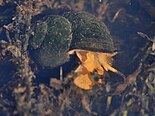 |
Crustacea
[edit]| Genus | Species | Stratigraphic position | Material | Notes | Images |
|---|---|---|---|---|---|
| Bulbilimnadia[5][9] |
|
|
Valves | A freshwater Ostracodan of the family Bulbilimnadiidae | |
| Darwinula[5] |
|
|
Valves | A freshwater Ostracodan of the family Darwinulidae |  |
| Euestheria[21][16][17] |
|
|
Valves | A Freshwater Clam shrimp (Phyllopodan) of the family Lioestheriidae. | |
| Isopodichnus[1][13] |
|
|
Hypichnial marks | Feeding and moving traces of phyllopod and notostracan crustaceans |
Insects
[edit]Radial chambers around large tunnels have been recovered, they may be arthropod burrows or traces of roots.[13][14] Large nest structures with septa, similar to nesting behaviour of insects like Cicadas are know.[14]
| Genus | Species | Location | Material | Notes | Images |
|---|---|---|---|---|---|
| Artematopodites[22] | A. ssp. |
|
MPK 5/36, 39, 40 | A Coleopteran, member of the family Permosynidae | |
| Blattodea[22] | Indeterminate |
|
MPK 5/54 | Indeterminate Blattodean remains | |
| Blattulidae[22] | Indeterminate |
|
MPK 5/1 | Indeterminate Cockroach remains | |
| Caraboidea[22] | Indeterminate |
|
MPK 5/12, 15 | Indeterminate Beetle remains | |
| Coleoptera[22] | Indeterminate |
|
Isolated Wings | Indeterminate Beetle remains | |
| Helminthoidichnites[14] | cf. H. isp. |
|
Gnawing traces | surficial gnawing traces made by insects | |
| Hydrobiites[22] | H. sp. |
|
MPK 5/10, 13, 17, 22, 25, 33 | A Coleopteran, member of the family Permosynidae | |
| Linckichnus[14] | L. terebrans |
|
Boring Traces | Detritivorous habitation dwellings or oviposition structures of insects in dead wood | |
| Memptus[22] | M. sp. |
|
MPK 5/44 | A Coleopteran, Incertade sedis | |
| Notocupes[22] | N. sp. |
|
MPK 5/6 | A Coleopteran, Incertade sedis | |
| Odrowazicoris[23] | O. polonicus |
|
MPK 5/2 | An Hemipteran, member of the family Belostomatidae | |
| Polysitum[22] | P.? sp. |
|
MPK 5/14, 29 | A Coleopteran, Incertade sedis | |
| Phoroschizidae[22] | Indeterminate |
|
MPK 5/4,5, 8, 20, 35 | Indeterminate Beetle remains | |
| Xylonichnus[14] | Cf.X. isp. |
|
Boring Traces | Borings in the wood made probably by insect larvae |
Fish
[edit]Unidentified Actinopterygian fish scales and teeth were collected from clayish, organic-rich lake deposits, while some coprolites have been referred to Hybodontiform sharks.[12]
| Genus | Species | Location | Material | Notes | Images |
|---|---|---|---|---|---|
| Semionotus[24] | S. cf. bergeri | Czarniecka Góra | Single specimen | A Semionotiform bony fish of the family Semionotidae |  |
| Paleoniscidae[12] | Indeterminate | Sołtyków | Scales & Teeth | Indeterminate Palaeonisciformes specimens |
Testudinata
[edit]| Genus | Species | Location | Material | Notes | Images |
|---|---|---|---|---|---|
| Chelonipus[12] | C. isp. | Sołtyków | Footprints | Turtle Tracks | |
| Testudinata[12] | Indeterminate | Sołtyków | Carapace Fragments | Unidentified Turtle remains, quoted to belong to a large sized taxon |
Synapsids
[edit]| Genus | Species | Location | Material | Notes | Images |
|---|---|---|---|---|---|
| Ameghinichnus[5][6][12] | Cf.A. isp. | Sołtyków | Footprints | Small Synapsid tracks, likely from Mammaliaformes |  |
| Brasilichnium[5][6] | B. isp. | Sołtyków | Footprints | Small Synapsid tracks, likely from Mammaliaformes | |
| Dicynodontipus[12] | D. isp. | Sołtyków | Footprints | Tracks referred to Eucynodonts, maybe Tritylodontidae |  |
| Therapsipus[5][12] | Cf.T. isp. | Sołtyków | Footprints | Tracks referred to Eucynodonts |
Rhynchocephalia
[edit]| Genus | Species | Location | Material | Notes | Images |
|---|---|---|---|---|---|
| Rhynchosauroides[5][12] | R. isp. | Sołtyków | Footprints | Tracks referable to both Sphenodontidae and Lepidosauromorpha |  |
Crocodrylomorphs
[edit]| Genus | Species | Location | Material | Notes | Images |
|---|---|---|---|---|---|
| Batrachopus[5][12] | B. isp. | Sołtyków | Footprints | Crocodrylomorph Tracks, likely of terrestrial taxa | 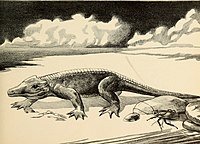 |
| Crocodylomorpha[12] | Indeterminate | Sołtyków | Bones inside a large bromalite | An Indeterminate Crocodrylomorph, likely preyed on by a large Theropod | |
| Crocodylomorpha[5] | Indeterminate | Sołtyków | Footprints | Unnamed 3rd type of Footprint | |
| Malutitetrapodiscus[5][12] | Cf.M. isp. | Sołtyków | Footprints | Probably left by small terrestrial crocodylomorphs |
Pterosauria
[edit]| Genus | Species | Location | Material | Notes | Images |
|---|---|---|---|---|---|
| Pteraichnus[5][12] | cf. P. isp. | Sołtyków | Footprints | Pterosaur Tracks, the individuals that left them probably had a wingspan of about 30-40 cm |  |
Theropods
[edit]Some elliptical "post-egg" structures egshells & eggs with embryo remains have been referred to theropods, yet may also belong to Ornithischians.[5]
| Genus | Species | Location | Material | Notes | Images |
|---|---|---|---|---|---|
| Anchisauripus[5][6][25][26][27] |
|
Sołtyków | Footprints | Adscribed to smal slender primitive predatory dinosaurs, related with genera such as Coelophysis |  |
| Eubrontes[5][6][26][27] |
|
Sołtyków | Footprints | Eubrontes is related to the Genus Dilophosaurus, representing a basal Neotheropods | 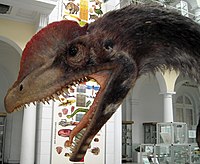 |
| Grallator[5][6][25][26][28] |
|
Sołtyków | Footprints | Similar pes with Coelophysidae-alike dinosaurs, related with neotheropods such as Dracoraptor. |  |
| Kayentapus[5][6][25][26][27] |
|
Sołtyków | Footprints | Assumed to come from Genera similar to Sarcosaurus |  |
| Megalosauripus[5][6][26][30] | Cf.M. isp. | Sołtyków | Footprints | Large bodied taxa, maybe related with Sinosaurus. Among the largest early Jurassic theropod tracks worldwide. |  |
| Plesiornis[5][6][26] |
|
Sołtyków | Footprints | Theropod Tracks from small sized taxa with convergent features with latter Avians | |
| Stenonyx[5][31] |
|
Sołtyków | Footprints | Small Theropod tracks, likely from juveniles of larger taxa | |
| Theropoda[5][12] | Indeterminate |
|
|
Some coprolites, referred to Theropods include plant material, probably ingested acidentally by drinking water.[11] Others include large bone remains or fish scales.[12] Teeth corroborate the presence of large taxa in the area.[12] |
Sauropodomorpha
[edit]| Genus | Species | Location | Material | Notes | Images |
|---|---|---|---|---|---|
| Kalosauropus[26] |
|
Gromadzice | Footprints | Tracks referred to early quadrupedal or semibipedal sauropodomorphs |  |
| Megaloolithidae?[32] | Indeterminate | Sołtyków | Eggshells, eggs with embryo remains & spherical "post-egg" structures | Nesting structures & associated eggs referred to sauropods |  |
| Otozoum[5][6][12] | Cf.O. isp. | Sołtyków | Footprints | Tracks referred to early quadrupedal or semibipedal sauropodomorphs | |
| Parabrontopodus[5][6][12] | P. isp. | Sołtyków | Footprints | Sauropod tracks, usually referred to taxa similar to Vulcanodon |  |
| Sauropodomorpha[12] | Indeterminate | Hucisko |
|
Indeterminate Sauropodomorph bones | |
| Tetrasauropus[5][6][12] | Cf.T. isp | Sołtyków | Footprints | Tracks referred to early quadrupedal or semibipedal sauropodomorphs |  |
Ornithischia
[edit]| Genus | Species | Location | Material | Notes | Images |
|---|---|---|---|---|---|
| Anomoepus[5][6][12] |
|
|
Footprints | Tracks that resemble the feet of "Stormbergia" and various Genasauria of different sizes |  |
| Delatorrichnus[5][6][12] |
|
Sołtyków | Footprints | Tracks usually referred to Heterodontosauridae or similar taxa |  |
| Moyenisauropus[33] |
|
Kontrewers | Footprints | Tracks adscribed to basal Thyreophora, vinculated with genera such as Scelidosaurus | 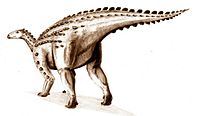 |
Plants
[edit]In Palynology, the Zagaje Formation belongs to the Nathorstisporites hopliticus assemblage (Isoetales), indicating a spike in marshland and lacustrine settings.[34] The Sołtyków outcrop is dominated by Classopollis (Cheirolepidiaceae), Aratrisporites (Cycadidae), Concavisporites (Dipteridaceae) and Cyathidites (Cyatheaceae).[8]
| Genus | Species | Stratigraphic position | Material | Notes | Images |
|---|---|---|---|---|---|
| Aciphyllum[11] |
|
|
Cuticles | Affinities with Pinaceae inside Pinales. The oldest record of a Pinus-like needle in the fossil record | |
| Brachyphyllum[11] |
|
|
Cuticles | Affinities with Cheirolepidiaceae or Araucariaceae inside Pinales | 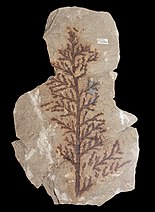 |
| Caytonia[12][35][36] |
|
|
Reproductive structure | Affinities with Caytoniaceae in the Caytoniales | |
| Czekanowskia[12] |
|
|
Branched Shoots | Affinities with the Czekanowskiales inside Ginkgoopsida. This Genus is related with relatively drier-cooler conditions. | |
| Desmiophyllum[11] |
|
|
Cuticles | A possible Conifer leaf, recent finds of it associated with the cone genera Sphaerostrobus and Ourostrobus points to a coniferophyte affinity, maybe as a member of Palissyaceae.[37] | |
| Dictyophyllum[12][35][36] |
|
|
Pinnae | Affinities with Dipteridaceae inside Gleicheniales. | 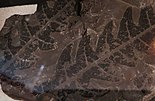 |
| Goepertella[12][35][36] |
|
|
Pinnae | Affinities with Dipteridaceae inside Gleicheniales | |
| Hirmeriella[12][38] |
|
|
Branched Shoots and reproductive cones | Affinities with the Cheirolepidiaceae inside Pinales. | |
| Komlopteris[11] |
|
|
Cuticles | Affinities Corystospermaceae inside Corystospermales. | |
| Matonia[39] |
|
|
Pinnae | Affinities with Matoniaceae inside Gleicheniales | |
| Neocalamites[12][35][36] |
|
|
Stems | Affinities with Calamitaceae inside Equisetopsida. A common horsetail on the Liassic of Europe. | 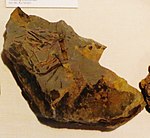 |
| Nilssonia[11] |
|
|
Cuticles | Affinities with Cycadeoidaceae in the Bennettitales or alternatively a member of Nilssoniales | 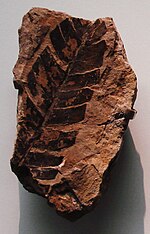 |
| Odrolepis[12][35][36] |
|
|
Complete Plants | Affinities with Lycopodiales | |
| Otozamites[12][35][36] |
|
|
Leaflets | Affinities with Williamsoniaceae in the Bennettitales. | 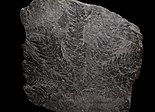 |
| Pachypteris[11][12][35][36] |
|
|
Pinnae | Affinities Corystospermaceae inside Corystospermales. | |
| Paracycas[12][35][36] |
|
|
Leaflets | Affinities with Cycadales in the Cycadopsida. | |
| Piroconites[12][35][36] |
|
|
Reproductive structure | Affinities with Gnetales, maybe with Welwitschiaceae | |
| Phlebopteris[12][35][36] |
|
|
Cuticles | Affinities with Matoniaceae in the Gleicheniales. | 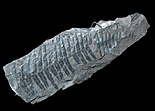 |
| Podozamites[11][12][35][36] |
|
|
Branched shoots | Affinities with Krassiloviaceae inside Voltziales | 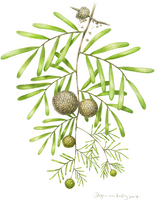 |
| Pseudotorellia[11] |
|
|
Cuticles | Affinities with the Pseudotorelliaceae inside Ginkgoopsida. | |
| Pterophyllum[11][12][35][36] |
|
|
Leaflets | Affinities with Williamsoniaceae in the Bennettitales. | 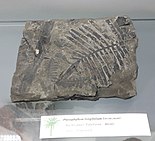 |
| Ptilozamites[11] |
|
|
Cuticles | Affinities Corystospermaceae inside Corystospermales. | |
| Sagenopteris[12][35][36] |
|
|
Leaves | Affinities with Caytoniaceae in the Caytoniales | 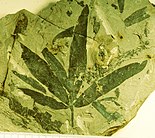 |
| Schmeissneria[12][40][36] |
|
|
Reproductive structure | Affinities with Ginkgoopsida or with Angiosperm-convergent Gimnosperms | |
| Swedenborgia[5][40] |
|
|
Branched Shoots | Affinities with Krassiloviaceae inside Voltziales. |  |
| Thaumatopteris[12][40][36] |
|
|
Pinnae | Affinities with Dipteridaceae inside Gleicheniales | |
| Todites[12][40][36] |
|
|
Pinnae | Affinities with Osmundaceae in the Osmundales. |
See also
[edit]- Blue Lias, England
- Charmouth Mudstone Formation, England
- Sorthat Formation, Denmark
- Hasle Formation, Denmark
- Drzewica Formation, Poland
- Ciechocinek Formation, Poland
- Borucice Formation, Poland
- Rotzo Formation, Italy
- Saltrio Formation, Italy
- Moltrasio Formation, Italy
- Marne di Monte Serrone, Italy
- Calcare di Sogno, Italy
- Podpeč Limestone, Slovenia
- Coimbra Formation, Portugal
- El Pedregal Formation, Spain
- Fernie Formation, Canada
- Whiteaves Formation, British Columbia
- Navajo Sandstone, Utah
- Aganane Formation, Morocco
- Tafraout Group, Morocco
- Azilal Formation, Morocco
- Budoš Limestone, Montenegro
- Kota Formation, India
- Cañadón Asfalto Formation, Argentina
- Los Molles Formation, Argentina
- Kandreho Formation, Madagascar
- Elliot Formation, South Africa
- Clarens Formation, South Africa
- Evergreen Formation, Australia
- Cattamarra Coal Measures, Australia
- Hanson Formation, Antarctica
- Mawson Formation, Antarctica
References
[edit]- ^ a b c d e f g h i j k l m n o Pieñkowski, G. (2004). "The epicontinental Lower Jurassic of Poland". Polish Geological Institute Special Papers. 12 (1): 1–154. S2CID 128922070.
- ^ Deutsche Stratigraphische Kommission (2016). "Stratigraphische Tabelle von Deutschland" (PDF). GeoForschungsZentrum. 1 (1): 1. Retrieved 22 December 2021.
- ^ Karaszewski, W. (1962). "The stratigraphy of the Lias in the Northern Mesozoic Zone surrounding the Święty Krzyż Mountains (Central Poland) [Eng. Sum.]". Pr. Inst. Geol. 30 (3): 333–416.
- ^ Weishampel, et al. (2004). "Dinosaur distribution." Pp. 517-607.
- ^ a b c d e f g h i j k l m n o p q r s t u v w x y z aa ab ac Niedźwiedzki, Grzegorz (2011). "Tropy dinozaurów z wczesnojurajskiego ekosystemu z Sołtykowa w Górach Świętokrzyskich". Biuletyn Państwowego Instytutu Geologicznego. 447 (447): 49–98. ISSN 0867-6143.
- ^ a b c d e f g h i j k l m n o p Gierliński, Gerard; Pieńkowski, Grzegorz; Niedźwiedzki, Grzegorz (2004). "Tetrapod Track Assemblage in the Hettangian of Sołtyków, Poland, and its Paleoenvironmental Background". Ichnos. 11 (3–4): 195–213. Bibcode:2004Ichno..11..195G. doi:10.1080/10420940490444861. ISSN 1042-0940.
- ^ Brañski, P. (2009). "Influence of paleoclimate and the green house effect on Hettangian clay mineral assemblages (Holy Cross Mts area, Polish Basin)". Geological Quarterly. 53 (3): 363–368.
- ^ a b c Krupnik, Joanna; Ziaja, Jadwiga; Barbacka, Maria; Feldman-Olszewska, Anna; Jarzynka, Agata (2014-06-01). "A palaeoenvironmental reconstruction based on palynological analyses of Upper Triassic and Lower Jurassic sediments from the Holy Cross Mountains region". Acta Palaeobotanica. 54 (1): 35–65. doi:10.2478/acpa-2014-0006. ISSN 2082-0259.
- ^ a b Pieńkowski, Grzegorz; Niedźwiedzki, Grzegorz; Brański, Paweł (2014), "Climatic reversals related to the Central Atlantic magmatic province caused the end-Triassic biotic crisis—Evidence from continental strata in Poland", Volcanism, Impacts, and Mass Extinctions: Causes and Effects, Geological Society of America, doi:10.1130/2014.2505(13), ISBN 978-0-8137-2505-5, retrieved 2024-11-27
- ^ Marynowski, L.; Simoneit, B. R. T. (2009-11-24). "Widespread Upper Triassic to Lower Jurassic wildfire records from Poland: evidence from charcoal and pyrolytic polycyclic aromatic hydrocarbons". PALAIOS. 24 (12): 785–798. Bibcode:2009Palai..24..785M. doi:10.2110/palo.2009.p09-044r. ISSN 0883-1351.
- ^ a b c d e f g h i j k l Barbacka, Maria; Górecki, Artur; Pacyna, Grzegorz; Pieńkowski, Grzegorz; Philippe, Marc; Bóka, Károly; Ziaja, Jadwiga; Jarzynka, Agata; Qvarnström, Martin; Niedźwiedzki, Grzegorz (2022). "Early Jurassic coprolites: insights into palaeobotany and the feeding behaviour of dinosaurs". Papers in Palaeontology. 8 (2). Bibcode:2022PPal....8E1425B. doi:10.1002/spp2.1425. ISSN 2056-2799.
- ^ a b c d e f g h i j k l m n o p q r s t u v w x y z aa ab ac ad ae af ag ah ai aj ak al am an Qvarnström, Martin; Vikberg Wernström, Joel; Wawrzyniak, Zuzanna; Barbacka, Maria; Pacyna, Grzegorz; Górecki, Artur; Ziaja, Jadwiga; Jarzynka, Agata; Owocki, Krzysztof; Sulej, Tomasz; Marynowski, Leszek; Pieńkowski, Grzegorz; Ahlberg, Per E.; Niedźwiedzki, Grzegorz (2024-11-27). "Digestive contents and food webs record the advent of dinosaur supremacy". Nature: 1–7. doi:10.1038/s41586-024-08265-4. ISSN 1476-4687. PMC 11634772. PMID 39604731.
- ^ a b c d e f g h i j k l m n o p q r PIEŃKOWSKI, GRZEGORZ (1985), "Early Liassic Trace Fossil Assemblages from the Holy Cross Mountains, Poland: Their Distribution in Continental and Marginal Marine Environments", Biogenic Structures, SEPM (Society for Sedimentary Geology), pp. 37–51, doi:10.2110/pec.85.35.0037, ISBN 0-918985-15-3, retrieved 2024-11-27
- ^ a b c d e f g h i j k l m n o p q r Pieńkowski, G.; Niedźwiedzki, G. (2008). "Invertebrate trace fossil assemblages from the lower Hettangian of Sołtyków, Holy Cross Mountains, Poland". Volumina Jurassica. 6 (1): 109–132.
- ^ a b Zaton, M.; Niedzwiedzki, G.; Pienkowski, G. (2009-08-20). "Gastropod egg capsules preserved on bivalve shells from the Lower Jurassic (Hettangian) of Poland". PALAIOS. 24 (9): 568–577. Bibcode:2009Palai..24..568Z. doi:10.2110/palo.2009.p09-005r. ISSN 0883-1351.
- ^ a b c d Samsonowicz, J . (1952). "Era mezozoiczna w Polsce". Zarys geologii Polski [in Polish]. 1 (2): 90–130.
- ^ a b Kopik, J. (1962). "Faunistic criteria of stratigraphical subdivision of the Lias in North-Western and Central Poland". Wyd. Geol. Warszawa: 271–312.
- ^ Pieńkowski, G.; Uchman, A. (2009). "Ptychoplasma conica isp. nov.: a new bivalve locomotion trace fossil from the Lower Jurassic (Hettangian) alluvial sediments of Sołtyków, Holy Cross Mountains, Poland". Geological Quarterly. 53 (4): 397–406.
- ^ Kopik, J. (1962). "Faunistic criteria of stratigraphical subdivision of the Lias in North-Western and Central Poland". Wyd. Geol. Warszawa: 271–312.
- ^ Kopik, J. (1962). "Faunistic criteria of stratigraphical subdivision of the Lias in North-Western and Central Poland". Wyd. Geol. Warszawa: 271–312.
- ^ Jurkiewiczowa, I. (1967). "Lias zachodniego obrzeżenia Gór Świętokrzyskich i jego paralelizacja z liasem Wyżyny Krakowsko-Częstochowskiej" (PDF). Biul. Inst. Geol. 200 (1): 5–132. Archived from the original (PDF) on 1 January 2022. Retrieved 1 January 2022.
- ^ a b c d e f g h i j Wegierek, P.; Zherikhin, V. V. (1997). "An Early Jurassic insect fauna in the Holy Cross Mountains" (PDF). Acta Palaeontologica Polonica. 42 (4): 539–543.
- ^ Popov, Y. A. (1996). "The first record of a fossil water bug from the Lower Jurassic of Poland (Heteroptera: Nepomoprha: Belostomatidae)". Polskie Pismo Entomologiczne. 65 (1): 101–105.
- ^ Maślankiewiczowa, Zofia (1995). "Semionotus cf. bergeri Agassiz from the Lias of the Holy Cross Mountains, Poland - Acta Palaeontologica Polonica". www.app.pan.pl. Retrieved 2024-11-28.
- ^ a b c Niedźwiedzki, G.; Remin, Z.; Roszkowska, J.; Meissner, U. (2008). "New finds of dinosaur tracks in the Liassic strata of the Holy Cross Mountains, Poland". Przegląd Geologiczny. 57 (1): 252–262. Retrieved 12 October 2021.
- ^ a b c d e f g Pacyna, G.; Ziaja, J.; Barbacka, M.; Pieńkowski, G.; Jarzynka, A.; Niedźwiedzki, G. (2022). "Early Jurassic dinosaur-dominated track assemblages, floristic and environmental changes in the Holy Cross Mountains region, Poland". Geological Quarterly. 66 (3): 66–29. doi:10.7306/gq.1660. S2CID 253535115. Retrieved 2 June 2023.
- ^ a b c Gierlinski, G. D. (2007). "New dinosaur tracks in the Triassic, Jurassic and Cretaceous of Poland". Jornadas Internacionales Sobre Paleontoloia de Dinosaurios y Su Entrono, Salas de los Infantes, Burgos, Spain: 13–16. Retrieved 12 October 2021.
- ^ Gierlinski, G.; Niedzwiedzki., G. (2005). "New saurischian dinosaur footprints from the Lower Jurassic of Poland". Geological Quarterly. 49 (1): 99–104. Retrieved 12 October 2021.
- ^ Gierliński, Gerard (1991). "New dinosaur ichnotaxa from the Early Jurassic of the Holy Cross Mountains, Poland". Palaeogeography, Palaeoclimatology, Palaeoecology. 85 (1–2): 137–148. Bibcode:1991PPP....85..137G. doi:10.1016/0031-0182(91)90030-u. ISSN 0031-0182.
- ^ Gierlinski, G.; Niedzwiedzki, G.; Pienkowski, G. (2001). "Gigantic footprint of a theropod dinosaur in the Early Jurassic of Poland". Acta Palaeontologica Polonica. 46 (3): 441–446.
- ^ Gierlinski, G.; Niedzwiedzki, G. (2002). "Enigmatic dinosaur footprints from the Lower Jurassic of Poland". Geological Quarterly. 46 (4): 467.
- ^ Pienkowski, G. (1998). "Dinosaur nesting ground from the Early Jurassic fluvial deposits, Holy Cross Mountains (Poland)". Geological Quarterly. 42 (4): 461–476.
- ^ Gierlinski, G. D.; Kowalski, K. Z. (2006). "Footprint of a large ornithischian from the ancient sacred site of Kontrewers, Poland". New Mexico Museum of Natural History and Science Bulletin. 37 (1): 217–220.
- ^ Marcinkiewicz, T.; Fijałkowska-Mader, A.; Pieńkowski, G. (2014). "Megaspore zones of the epicontinental Triassic and Jurassic deposits in Poland–overview. Biuletyn Państwowego". Instytutu Geologicznego. 457 (7): 15–42.
- ^ a b c d e f g h i j k l m Barbacka, Maria; Pacyna, Grzegorz; Feldman-Olszewska, Anna; Ziaja, Jadwiga; Bodor, Emese (2014-12-10). "Triassic-Jurassic Flora of Poland; Floristical Support of Climatic Changes". Acta Geologica Polonica. 64 (3): 281–309. Bibcode:2014AcGeP..64..281B. doi:10.2478/agp-2014-0015. ISSN 2300-1887.
- ^ a b c d e f g h i j k l m n o p Barbacka, Maria; Ziaja, Jadwiga; Wcislo-Luraniec, Elzbieta (2010-09-10). "Taxonomy and palaeoecology of the Early Jurassic macroflora from Odrowąż, central Poland". Acta Geologica Polonica. 60 (3): 373–392.
- ^ van Konijnenburg-van Cittert, J.H.A.; Schmeißner, S.; D., G.; Kustatscher, E.; Pott, C. (2024-03-13). "Plant macrofossils from the Rhaetian of Einberg near Coburg (Bavaria, Germany). Part 3. Conifers, incertae sedis and general discussion". Neues Jahrbuch für Geologie und Paläontologie - Abhandlungen. 310 (3): 251–282. doi:10.1127/njgpa/2023/1182. ISSN 0077-7749.
- ^ Barbacka, M.; Ziaja, J.; Wcisło-Luraniec, E.; Reymanówna, M. (2007). "Hirmeriella muensteri (Schenk) Jung from Odrowąż (Poland), with female and male cones, and in situ Classopolis pollen grains" (PDF). Acta Palaeobotanica. 47 (2): 339–357.
- ^ Barbacka, Maria; Pacyna, Grzegorz; Pieńkowski, Grzegorz; Ziaja, Jadwiga (2016-12-15). "New data about Matonia braunii (Göppert) Harris from the Early Jurassic of Poland and its ecology". Geological Quarterly. 60 (4). doi:10.7306/gq.1322.
- ^ a b c d Pacyna, G. (2013). "Critical review of research on the Lower Jurassic flora of Poland". Acta Palaeobotanica. 53 (2): 141–163. doi:10.2478/acpa-2013-0015. S2CID 129464899. Retrieved 13 October 2021.
Bibliography
[edit]- Weishampel, David B.; Dodson, Peter; Osmólska, Halszka (2004), The Dinosauria, 2nd edition, Berkeley: University of California Press, pp. 1–880, ISBN 0-520-24209-2, retrieved 2019-02-21

